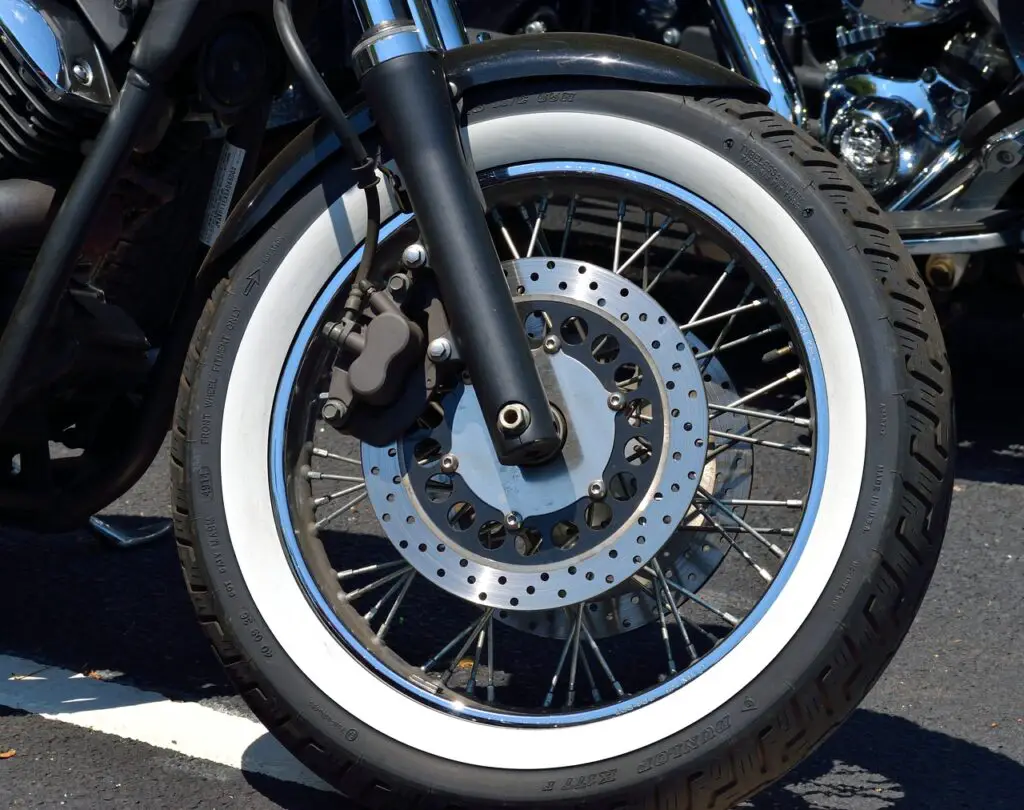Owning a motorcycle can get expensive, so most riders are always keeping an eye out for places where they can cut costs. You may have noticed that brake fluid is significantly cheaper for cars than for motorcycles. Is this a place where you can cut costs?
Car brake fluid and motorcycle fluid are interchangeable. Rather than looking for motorcycle brake fluid instead of car brake fluid, you just need to make sure that the fluid you buy is the correct type for your motorcycle, whether that be DOT4, DOT3, DOT5.1, or DOT5.
Disclaimer: Breaks are extremely important, especially on a motorcycle. Gather advise from a mechanic if you want to work on your breaks. I’m not a licensed mechanic and I am not responsible for the correct operation of your brakes.
You need the right kind of brake fluid, but it might be labeled as car brake fluid. This is okay. What’s important is learning the proper maintenance and getting the right type of brake fluid. More on that below.

Is car brake fluid the same as motorcycle brake fluid?
Cars and motorcycles both need brake fluid. This is what keeps the brakes working smoothly. I’m sure I don’t need to explain the benefits of working brakes!
There are four types of brake fluid: DOT3, DOT4, DOT5, and DOT5.1. I’ll get into the details of what sets these each apart below, but for know you just need to know which one you need. This should be in your service manual.
Some of these types of brake fluid can be found as labeled for cars or motorcycles. Often, the brake fluid for cars comes in bigger containers for a better price. Obviously it makes sense to buy the cheaper option if you can, so this is a common question among motorcycle riders.
Luckily, car brake fluid can be used for motorcycles, as long as it’s the correct type; ie, DOT3 or DOT4.
One thing to know if you’re buying a large container of brake fluid is that you shouldn’t use brake fluid that’s been open for long. As air and moisture get into the container, the fluid will become unusable.
You’re probably safe to use brake fluid from the same container twice if it’s properly sealed between uses, but any more than that can be risky.
This is why motorcycle brake fluids often come in smaller containers meant for a single use.
What is proper motorcycle brake maintenance?
Brakes are incredibly important for a motorcycle. If you can’t stop your bike, well, you’ve got a problem.
Motorcycle brakes also need a lot of care in order to make sure they’re in prime shape. In fact, motorcycle brakes need a lot more maintenance than cars.
A good rule of thumb is to check the brakes as often as you check your tire pressure. If the fluid is low, this could be a sign that your brake pads are worn down, and just dripping some more fluid in won’t solve the problem.
You should also check the color of your brake fluid to make sure it’s still good. Brake fluid should be fairly light in color. If it’s turned a dark golden or brown color, it probably needs replaced.
Even without significant change in color, it’s a good idea to replace your brake fluid approximately every other year. Brake fluid absorbs moisture over time and should be renewed in order to give the best results.
You should change your brake pads whenever they get down to about ⅛ an inch. Important note: even if one side is much thinner than the other, you should always replace both at the same time. This is not the place to try and save a buck.
How do you replace brake fluid?
I actually won’t go very in depth into the process of replacing brake fluid. There are a myriad of great videos online which can walk you through the process. Some things are just much easier to see than to read!
However, I did want to give a quick run-down, along with some tips for making the process a little easier.
The first tip is to prepare your workstation! Brake fluid is toxic and very strong. You’ll want to wear gloves while you’re changing the fluid, and you’ll want to cover the bike just in case of spills, since brake fluid can damage paint.
You should have a protected work surface nearby to use while you work.
You’ll first need to locate the reservoir and remove the cap and rubber accordion gasket. Clean these as you go to make life easy for yourself!
Once you’ve removed the cap, it’s time to pull out your bleeding kit. The bleeding kit is essentially a tube that will streamline the switch.
Put one end of the tube in a collecting container and attach the other to the bleeder bolt. Make sure the reservoir is full to begin, then start pumping, slowly filling the reservoir as it empties.
The new brake fluid will be much lighter in color, so you’ll know you’re finished when the tube shows the lighter liquid coming from the bleeder bolt.
When you’re finished, carefully clean everything and replace the caps. Then, find a way to dispose of the old brake fluid. Don’t just throw it in the trash, take it to a mechanic if you don’t have a way to safely dispose of it yourself.
Are there different types of brake fluid?
Now, before finishing, let’s get into some of the details of the different types of brake fluid. There are four main types: DOT3, DOT4, DOT5, and DOT5.1. The DOT just stands for Department of Transportation, and the numbers refer to the brake fluid’s boiling point.
DOT3, DOT4, and DOT5.1 are all glycol based. They have different boiling points but share some compatibility. If you put DOT3 brake fluid in a motorcycle that recommends DOT4, you’re probably okay.
I would, however, recommend that you stick to the listed brake fluid. There’s a reason the manufacturer made that call, and the bike may not run as well if you switch to another brake fluid.
DOT5, however, is silicone based. You cannot mix DOT5 with any of the others. (No, not even DOT5.1.)
DOT5 isn’t very common in motorcycles nowadays, so you probably won’t need to worry about this. But it’s important to know that it is not compatible with the others, and could even ruin your brakes if you mixed them.
The correct DOT for your bike should be listed on the reservoir cap when you go to check the brake fluid. If not, it’ll be in your service manual. You can always get an opinion from a mechanic as well if you aren’t sure which brake fluid you need.
They can also recommend a brand, whether it’s labeled for motorcycles or for cars.
